
Search Wild Foods Home Garden & Nature's Restaurant Websites:
Lamium Genus - Henbit, Purple Deadnettle & White Nettle
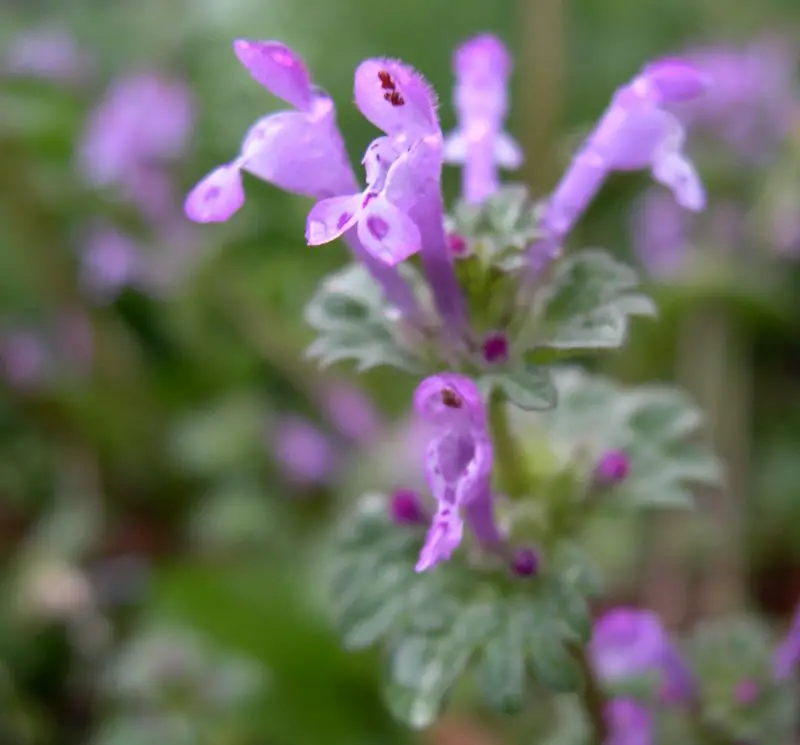
Picture of Henbit flowers *
(NOTE: If you are not interested in growing Deadnettles, but just finding the plants and using them, try going to the Nature's Restaurant Online site for the Lamium Genus.)
Deadnettle (Lamium) genus has three edible plants in it that are found in eastern North America. The Henbit (Lamium amplexicaule), the Purple Deadnettle (Lamium purpureum), and the White Nettle (Lamium album). The "Deadnettle" name comes from how they look like the Stinging Nettle (Urtica dioica), but don't sting. In other words, the stinging aspect of the plant is dead.
As a general rule, they are a safe edible, but to be honest, given the choice between any of the (Lamium) genus, and the Stinging Nettle, I'll take the Stinging Nettle - if it is in season. The advantage of the Lamium is the season is longer. The Stinging Nettle looses its great taste very quickly as the season moves on - only the top leaves are good when young in spring. Another advantage of the Lamium is the taste is more consistent, whereas with Stinging Nettle the taste varies greatly from patch to patch. And, of course, there is no chance of getting stung with the Lamium - I don't think I've ever gotten away without getting stung when gathering Stinging Nettles.
Is the growing of this plant compatible with Natural farming, Ecoagriculture or Eco friendly agriculture, Ecological farming, Sustainable agriculture, Agroforestry or Agro-sylviculture and Permaculture: Natural farming or no-till garden methods are perfect for this group of plants. There is no need to ever turn the soil once this plant has established.
Soil & Site: These plants can do well in full sun, partial shade or full shade as long as it isn't too dark. Though you can grow them in full sun, in the heat of summer sun they will die back, and return in the fall or again next spring. For growing them, whatever area you have should work as long as the soil is not soaking wet. The ideal conditions are shade in the midday sun, with full sun in the morning, on moist, nutrient rich soil that drains well and stays moist. This group of plants responds well to nitrogen in the soil. They do best in neutral to slightly alkaline soils, making this a good ground cover and food greens plant for those who live where is a lot of limestone rock around and in the soil.
Seeds: You can start them by seed found on plants in the wild. You could spread them in the fall on the ground, tamp, and cover with a mulch, or plant in the spring after the chance of frost is over. You might be able to find seeds for these at speciality seed houses. Henbit seeds. Purple Deadnettle seeds. White Nettle seeds.
Transplanting: These plants transplant well, and you can do it any time of the season, though of course, spring and fall are the best. Just dig up a section of them, put in a container like a plastic bag or bucket and plant in the prepared soil at home. Water well if you transplant in the spring or summer, and mulch well if you transplant in the late fall.
Maintenance: In the fall or very early spring, just spread some compost and lime or composted manure lightly around where they grow and cover with a fresh layer of mulch.
Harvesting: Just pick upper leaves and stems in the spring and summer. As the season moves on, don't eat the stems - they get tougher, but leaves are good to mid summer or later.
Using: Just use like a vegetable green. In stir-fry's, soups, etc. You don't need to boil and toss the water first - just use them.
Henbit (Lamium amplexicaule). Known also as Henbit Deadnettle and Greater Henbit.
Very similar looking the Purple Deadnettle listed right below. Not a problem if you confuse one for the other, as they can be used interchangeably. The upper leaves on the Purple Deadnettle have obvious stems and the more triangular leaves are tinted slightly burgundy-purple, whereas with the Henbit, the rounder upper leaves are stemless and are greener.
If you look closely at the flower, on the lower petal, it narrows about a third from the end, then widens again forming what looks like two more petals on the end. Very often, on this part which is light in color there are darker dots of color that look like a face - two eyes close to the trumpet like opening of the flower, with the mouth at the thin part. Also, the upper petal has a fine hairy quality on the top which is of richer color.
The very upper leaves often have a reddish outline at the margins, and sometimes on the back of the leaf veins.
As far as using goes, it is fairly straight forward. Just use like any cooked green. Take the top of a growing shoot, stem and all, rinse, chop up and add to whatever you are cooking that you want greens in. Although the taste is unique, it is fairly mild, so whatever you spice with will be the main taste. You don't have to boil in water and pour off the water first - just use them. They cook fairly fast, ten minutes until soft in steam or water. By the way, even though this is part of the mint family (square stem is the clue), it does not taste of mint at all. I find that the flavor is enhanced by something acidic, like adding a touch of Apple Cider Vinegar or Lemon Juice near the end of cooking.
Description:
- USDA Plant Hardiness Zone: 4-8 (More information on hardiness zones).
- Soil pH: 6.1-8.6
- Plant Size: 10-25 cm (4 to 9 inches) in height, though tends to sprawl across the ground.
- Duration: Winter Annual
- Leaf Shape: Rounded to Heart shaped with very obvious veining that is topographical - veins are lower that the surface of the top of the leaf.
- Leaf Phyllotaxis (Arrangement) on branch: Decussate (Alternating Opposites. That is, they come in Opposite pairs that Alternate on the stem - if looking at the plant from above, you will have one pair at three and nine o'clock, then the next pair at twelve and six o'clock.)
- Leaf Size: 2.5 cm (1 inch) long and wide
- Leaf Margin: Large, rounded teeth on edge
- Leaf Notes: Leaves are finely hairy. Hairs are soft. Lower leaves have obvious stems, upper leaves appear stemless, and in pairs around stem giving the appearance of the pair of leaves being one leaf wrapped right around the stem
- Flowers: Appear in whorls around the stem at the same point the leaves attach to the stem. Flowers are tube to trumpet shaped, with two lips at the end. Pink to Purple-pink.
- Fruit: Very small, speckled, grey-brown, egg shaped nutlets
- Stem: Stem is square - four sided. Stem is finely hairy with soft hairs. Stems can have reddish hue on squared edges
- Habitat: Colonizes disturbed soils in a wide variety of conditions. Gardens, waste areas, fields.
Web Resources:
- Recipe search on the web here (Google search) and here (Bing search).
- Pictures on the web here (Google images) and here (Bing images).
- Interactive USDA distribution map and plant profile here.
- The Biota of North America Program (BONAP) distribution map here. BONAP map color key here.

Henbit (Lamium amplexicaule) range. Distribution map courtesy of U. S. Department of Agriculture (USDA Natural Resources Service) and used in accordance with their policies.
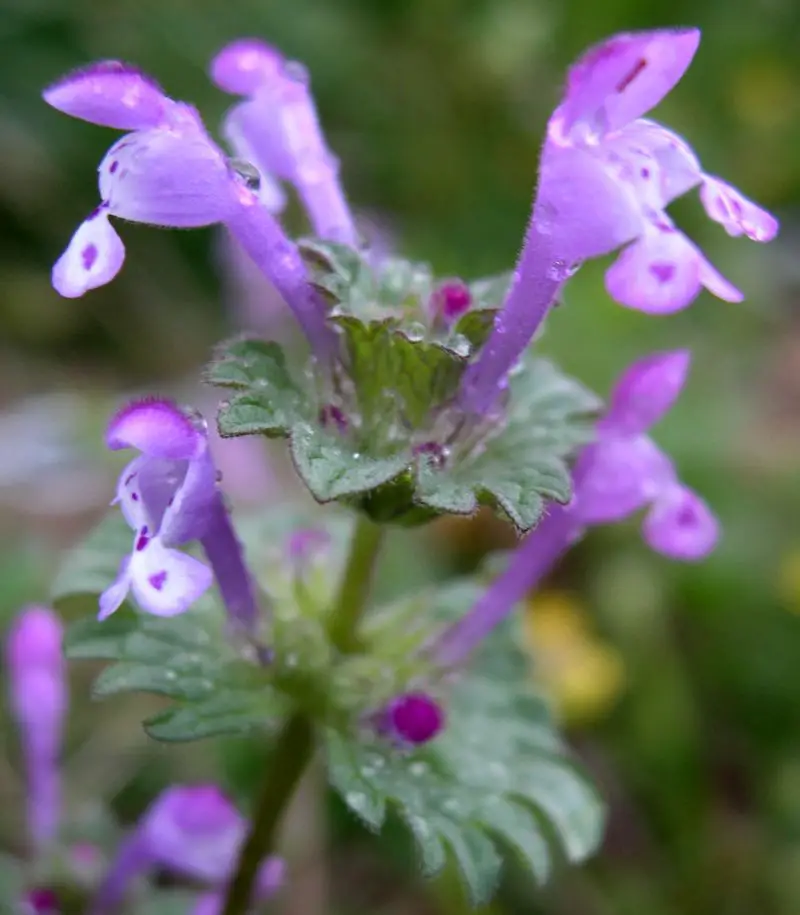
Picture of Henbit Flowers *
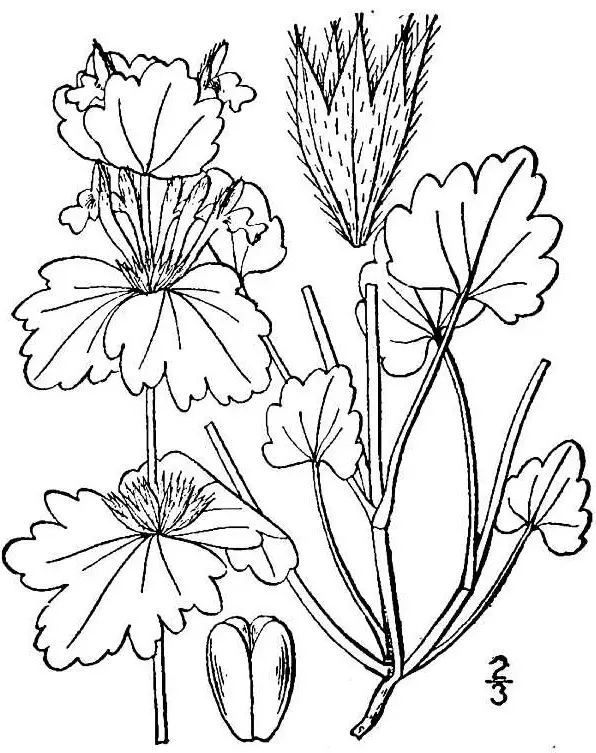
Henbit drawing. (USDA-NRCS PLANTS Database / Britton, N.L., and A. Brown. 1913. An illustrated flora of the northern United States, Canada and the British Possessions. 3 vols. Charles Scribner's Sons, New York. Vol. 3: 121)

Henbit seeds. (Steve Hurst, hosted by the USDA-NRCS PLANTS Database)
Purple Deadnettle (Lamium purpureum). Known also as Red Deadnettle, Purple Archangel and Velikdenche. Although part of the mint family, it doesn't smell minty, but there is a hard to describe scent.
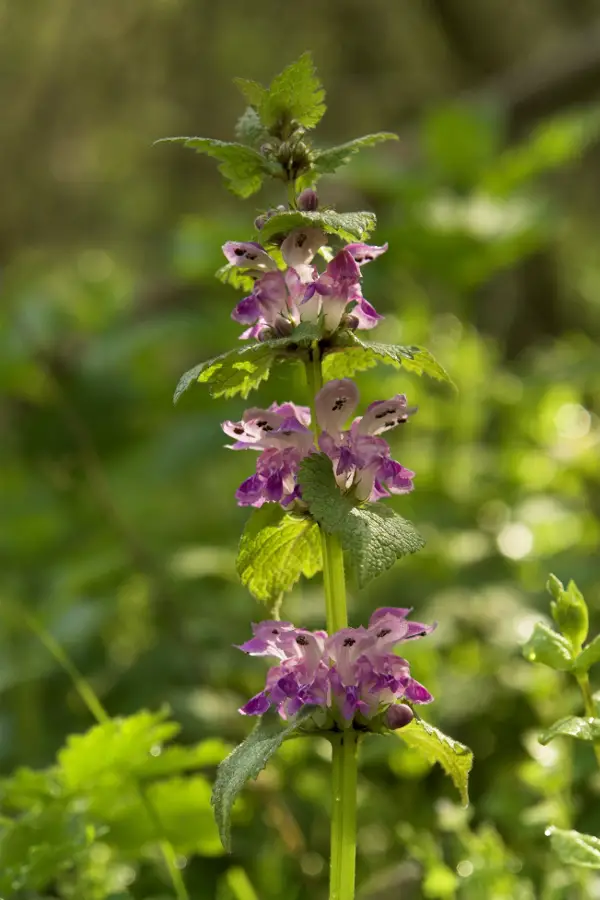
Purple Deadnettle
For the most part, just treat the same as the very similar looking Henbit listed above. Best early in the season, although if you like the flavor of it, it does get stronger as the plant goes into flower.
Although you can eat this plant raw, there is a smell to it raw I don't care for, however the taste does not reflect the smell. Best cooked, in stir-fry's or with cooked foods. The upper stems, flowers and leaves are edible, so just cut off the top section and use.
The upper leaves on the Purple Deadnettle have obvious stems and the more triangular leaves are tinted slightly burgundy-purple, whereas with the Henbit, the rounder upper leaves are stemless and are greener. From an eating point of view, it doesn't really matter if you mix them up.
Description:
- USDA Plant Hardiness Zone: 3-8 (More information on hardiness zones).
- Soil pH: 6.1-8.6
- Plant Size: Up 30 cm (12 inches) tall
- Duration: Winter Annual or Annual
- Leaf Shape: A cross between heart shaped and triangular
- Leaf Phyllotaxis (Arrangement) on branch: Decussate (Alternating Opposites. That is, they come in Opposite pairs that Alternate on the stem - if looking at the plant from above, you will have one pair at three and nine o'clock, then the next pair at twelve and six o'clock.)
- Leaf Size: 2-4 cm (4/5 to 1 3/5 inches) long with 1-2 cm (2/5 to 4/5 inches) long leaf stalk
- Leaf Margin: Rounded sawtooth, sometimes wavy
- Leaf Notes: On bottom of plant leaves are green, at the top they are a reddish-maroon color. Leaves have fine, soft hairs and very obvious veining in which the veins are lower that the rest of the upper side of the leaf.
- Flowers: color varies from pink, to pink-purple, mauve to reddish-purple. Flowers come from node on stalk where leaves come from. Leaves and flowers form clusters on the tops of stems. The flower is vertically bilaterally symmetrical, which means: if you imagine a line from top to bottom of the center of the flower, each side is a mirror image. If you divide it horizontally, the halves are not mirror images. Trumpet shaped with upper cover or cap, and lower petal splits into a double petal
- Habitat: Very adaptable to almost any habitat other than dark shade or constantly wet soil. Tolerant to varying acidity/alkalinity. Sand, loam or clay. Can form mats.
Web Resources:
- Recipe search on the web here (Google search) and here (Bing search).
- Pictures on the web here (Google images) and here (Bing images).
- Interactive USDA distribution map and plant profile here.
- The Biota of North America Program (BONAP) distribution map here. BONAP map color key here.
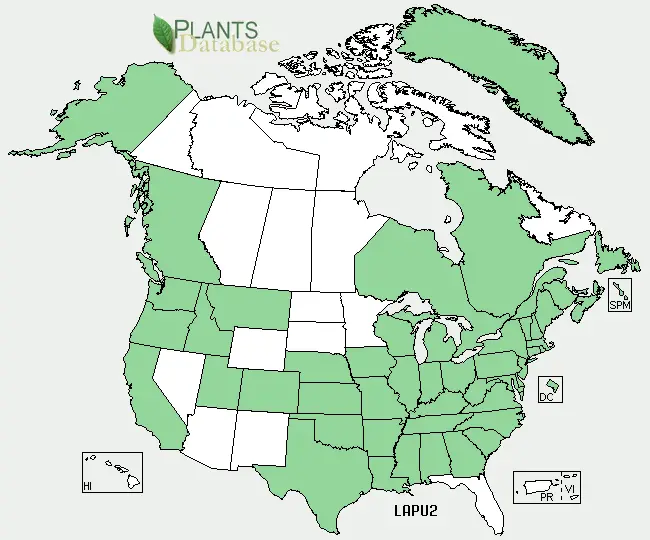
Purple Deadnettle (Lamium purpureum) range. Distribution map courtesy of U. S. Department of Agriculture (USDA Natural Resources Service) and used in accordance with their policies.
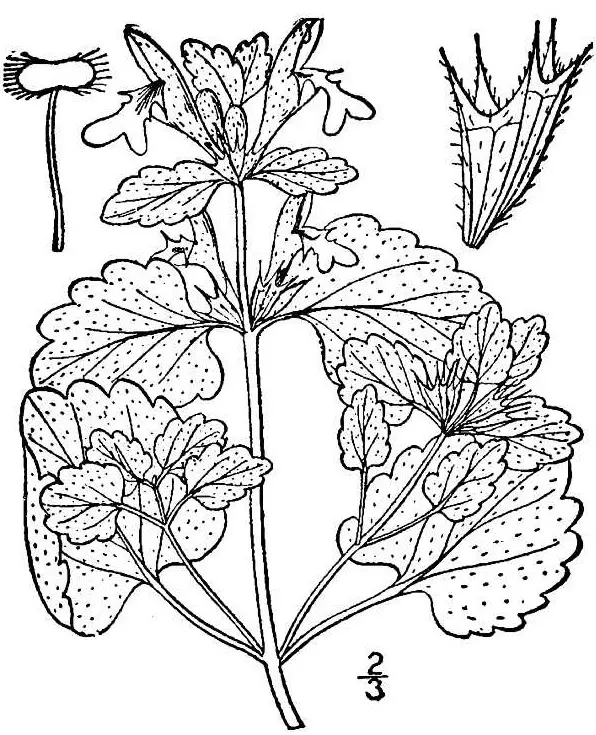
Purple Deadnettle drawing. (USDA-NRCS PLANTS Database / Britton, N.L., and A. Brown. 1913. An illustrated flora of the northern United States, Canada and the British Possessions. 3 vols. Charles Scribner's Sons, New York. Vol. 3: 121)
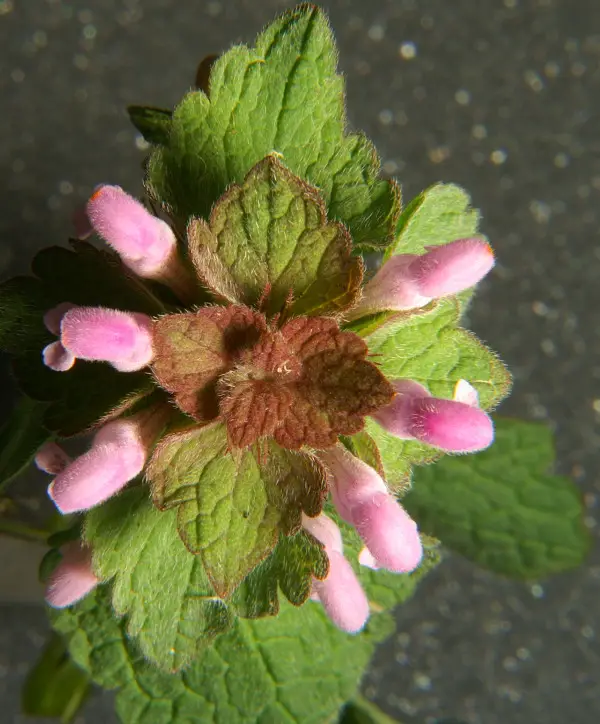
Purple Deadnettle looking straight down.
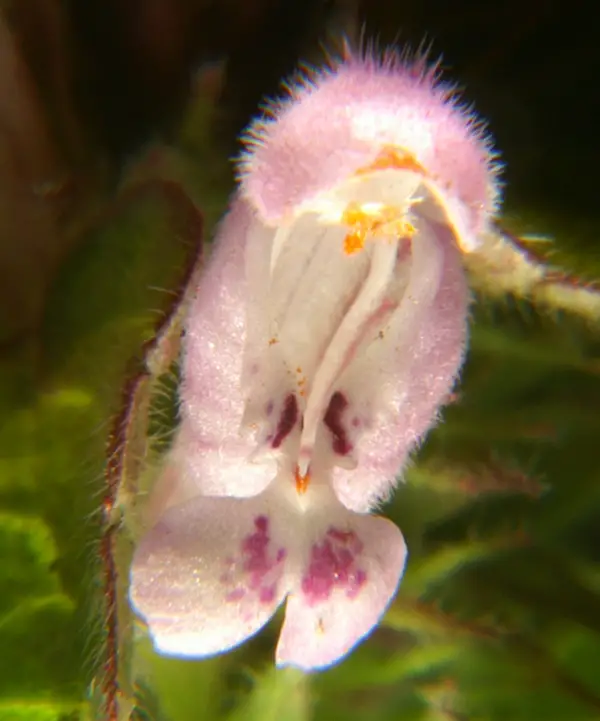
Purple Deadnettle flower
White Nettle (Lamium album) also known as Bee Nettle (Bees like the flowers), Deadnettle and White Dead-nettle in Europe. Not related to the Stinging Nettle despite the name and the fact that the leaves look quite similar.
White Nettle
Young leaves from the plant can be used in salads and cooked, while the leaves of the plant in flower are good only cooked. I will eat these, but if I can get good Stinging Nettles in season, I prefer them. Cook a few of them in with any meal like any other green. Nothing special taste wise, but nothing bitter or unpleasant either.
Description:
- USDA Plant Hardiness Zone: 3-10 (More information on hardiness zones).
- Soil pH: 4.5-8.5
- Plant Size: 50-100 cm (20 to 40 inches) tall
- Duration: Winter Annual or Perennial
- Leaf Shape: A triangular Ovate coming to pointed tip and rounded at the base.
- Leaf Phyllotaxis (Arrangement) on branch: Decussate (Alternating Opposites. That is, they come in Opposite pairs that Alternate on the stem - if looking at the plant from above, you will have one pair at three and nine o'clock, then the next pair at twelve and six o'clock.)
- Leaf Size: 3-8 cm (1 1/5 to 3 inches) long and 2-5 cm (3/4 to 2 inches) wide
- Leaf Margin: Serrated (Sawtooth)
- Leaf Notes: Soft, fine hairs on leaves
- Flowers: Whorls of flowers coming from where leaves come from stem, not just at the top, but in the upper section. Flowers are white, look sort of like Snapdragon flowers with four dark dots on the top petal that are usually peanut shell shaped. Often you have to turn the plant to see the dots, as the upper petal acts like a hood with the dots on the side facing down. Sometimes, they look just like six dots, but not peanut shell shaped.
- Habitat: Like moist (but not wet) rich soils in open or partly shaded areas. Grasslands, open woods, open areas near rivers and creeks.
Web Resources:
- Recipe search on the web here (Google search) and here (Bing search).
- Pictures on the web here (Google images) and here (Bing images).
- Interactive USDA distribution map and plant profile here.
- The Biota of North America Program (BONAP) distribution map here. BONAP map color key here.
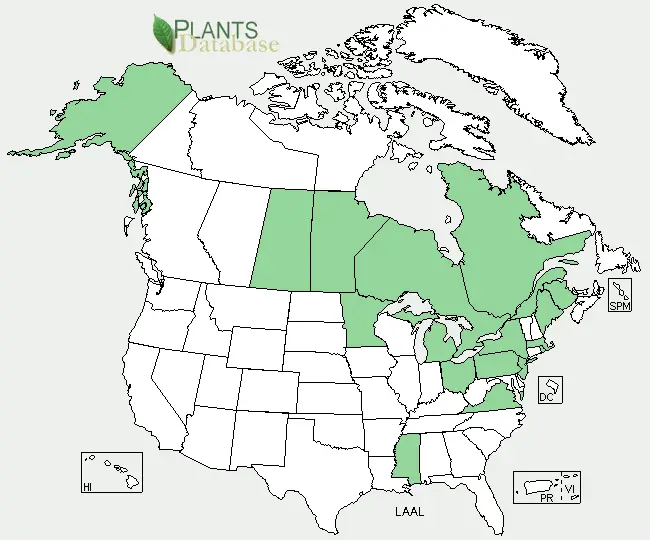
White Nettle (Lamium album) range. Distribution map courtesy of U. S. Department of Agriculture (USDA Natural Resources Service) and used in accordance with their policies.
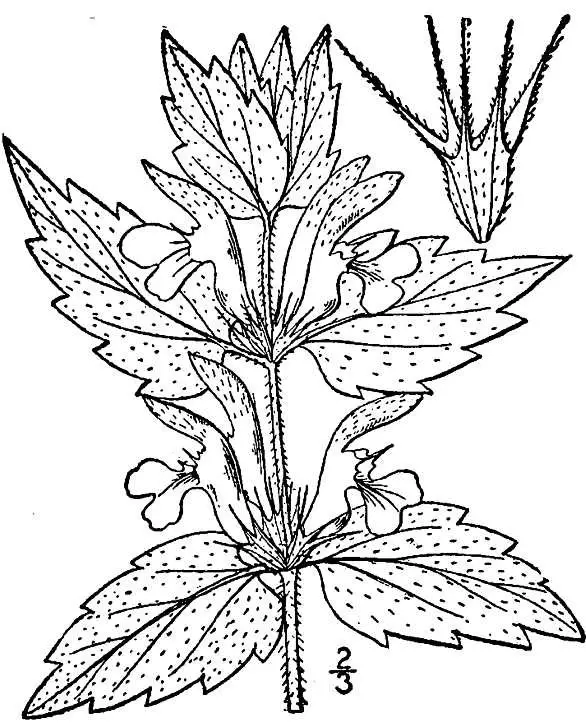
White Nettle drawing. (USDA-NRCS PLANTS Database / Britton, N.L., and A. Brown. 1913. An illustrated flora of the northern United States, Canada and the British Possessions. 3 vols. Charles Scribner's Sons, New York. Vol. 3: 122.)
Search Wild Foods Home Garden & Nature's Restaurant Websites:
Share:
Why does this site have ads?
Originally the content in this site was a book that was sold through Amazon worldwide. However, I wanted the information to available to everyone free of charge, so I made this website. The ads on the site help cover the cost of maintaining the site and keeping it available.
Google + profile
